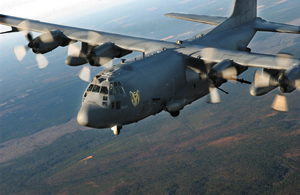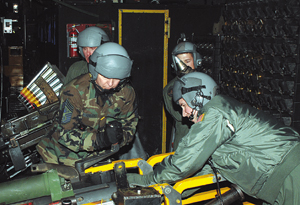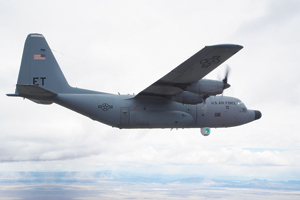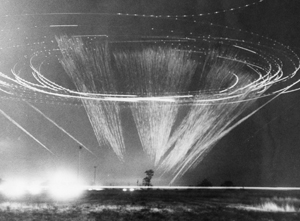America’s long-running military struggles in Iraq and Afghanistan have reaffirmed a long-standing truth about airpower in irregular war: When you go into combat, never go without USAF’s deadly side-firing gunships somewhere nearby.
Today’s AC-130s are upholding a stellar combat tradition extending from the early days of Vietnam in the 1960s through the operations in Grenada, Panama, Kuwait, Somalia, and the Balkans. And US ground commanders of the future, no less than those of today, will surely ask, “Where are the gunships?”
 |
An AC-130U Spooky flies a training mission over Hurlburt Field, Fla |
In the future, however, those gunships might not be there. Air Force Special Operations Command’s 25 AC-130s are, on average, almost 30 years old. Searches for a successor have stalled. All of them will have to be retired or rebuilt within 10 years. As a result, these highly effective weapons might be fading out.
Although several studies on a “next generation gunship” were conducted—and a test program for a smaller platform proposed—there is no gunship program now on the books.
“There’s really nothing to report on that,” noted Lt. Col. Michael Nardo, gunship requirements officer and AC-130 instructor pilot at the 1st Special Operations Wing at Hurlburt Field, Fla. “There’s been no decision made to proceed with any other airframe.”
The gunship is a relatively new airpower innovation. It first appeared in the 1960s, in the Vietnam War. AC-47s were World War II-era C-47 transports fitted with an array of heavy armament and targeting gear. They tended to operate at night, and the troops called them “Spooky.” Whether they were known as “Spooky” or “Shadow” or “Stinger”—or more popularly, “Puff the Magic Dragon”—Vietnam-era AC-47s, AC-119s, and AC-130As wreaked havoc on enemy supply lines and kept the enemy from overrunning many isolated US military outposts.
Today, they are heavily involved in the greater Middle East. AFSOC’s modern-day AC-130s are prized for their ability to loiter over targets until the time comes to unleash a deadly and accurate fusillade. Ground forces love them.
In November 2001, Gen. James L. Jones, then the Marine Corps Commandant (and now President Barack Obama’s national security advisor) said he was so impressed with their work over Afghanistan that he wanted to get some for the Corps. “Frankly, I’m kicking myself that I waited so long,” Jones said.
More recently, Gen. James T. Conway, today’s Commandant, allowed that the marines “have lusted for years” for AC-130s of their own, but could not afford them.
The current force consists of eight AC-130H Spectre aircraft, the first of which entered service in 1969, and 17 AC-130U Spooky gunships, which have an average age of about 20 years. Both versions are armed with a 40 mm rapid-fire gun and a 105 mm cannon. The U models also carry a 25 mm Gatling gun.
What makes the gunship so effective in current-day engagements, however, is its suite of electro-optical and infrared sensors and computerized fire-control systems. These systems allow deadly accuracy in the darkness and low-light conditions in which the AC-130s typically operate.
The newer Spookys also are equipped with AN/APQ-180 synthetic aperture strike radar of the kind used by the F-15E fighter. This radar allows long-range target detection and identification. It lets targeting airmen see the impact point of their rounds and adjust fire without requiring a ground observer.
 |
Then-CMSAF Rodney McKinley (l) helps MSgt. Preface Hedin (r) and SSgt. James Mobley (rear right) load the 105 mm Howitzer aboard an AC-130H gunship while SrA. Mathew Busman (rear left) works the 40 mm Bofors cannon. |
Gunship Lite
The radar also gives the U model the ability to engage targets in poor weather conditions, Nardo said.
Because of their ability to provide high-quality surveillance, to deliver heavy and precise fire, and to remain on station for hours, the gunships, their crews, and support personnel are constantly being deployed from their home at Hurlburt. The details of their deployments are kept secret.
“They definitely are in high demand,” said Nardo.
The handful of current gunships are heavily utilized low-density, high-demand assets, however, which is creating growing concern about airframe fatigue and rising maintenance costs.
In 2001, the Pentagon funded a technology demonstration project aimed at producing a new gunship. This project, called AC-X, was to examine the relative merits of making further upgrades to the existing AC-130s or pursuing a new platform. No procurement program emerged from that study.
The desire for an advanced capability remains. AFSOC officials have long desired a new design that could overcome the AC-130’s limitations. Today’s gunships are slow, fly primarily at night and at set altitudes, and attack while making a series of left turns around a target. It is preferable to keep them in low-threat environments.
In 2007, Lt. Gen. Michael W. Wooley, then AFSOC commander, said the command was interested in developing a system of manned and unmanned platforms that would provide a “technological leap” to replace the current gunships.
Wooley emphasized the value of stealthy platforms to reduce the threat to the gunships. He discounted use of the new and more powerful C-130Js, which AFSOC was already buying to replace the aged MC-130E/H Combat Talon special operations transports.
The general suggested that the new gunship might in turn be a derivative of the proposed next generation bomber, a heavy, long-range aircraft intended to have the best of the current low observable technology and which was supposed to be fielded by 2018. That concept did not gain much support, and, in any event, the Pentagon in April scrapped that bomber program.
For the near-term, AFSOC had studied the feasibility of a much smaller aircraft under an initiative called AC-XX or “Gunship Lite.” Command officials saw value in a platform that would present a smaller target and could operate with fewer crew members than the 13 currently required on the AC-130.
 |
Maintainers assigned to the 1st Special Operations Aircraft Maintenance Squadron work on an AC-130H’s newly installed engine at Hurlburt Field. |
Keeping Them Visible
An analysis of alternatives conducted last year determined that the best candidate for AC-XX was the C-27J, a twin-engine turboprop that the Air Force and Army were to buy under the Joint Cargo Aircraft program.
Then-Brig. Gen. Bradley A. Heithold, AFSOC’s top requirements officer at the time, previously told reporters the AC-27J would be named Stinger, in honor of the Vietnam-era AC-119s. Heithold said the new AC-27J would be a multimission aircraft capable of covertly transporting special operations fighters into and out of hostile areas, as well as providing airborne fire support.
Heithold added that obtaining a replacement aircraft was becoming urgent for AFSOC because of the wing box fatigue problem and obsolescent avionics in the AC-130s.
Gen. T. Michael Moseley, then Air Force Chief of Staff, told a Congressional hearing during last year’s budget deliberations that an AC-27J could be based at Cannon AFB, N.M., where AFSOC is rapidly building up its aviation capabilities. Moseley said basing gunships at Cannon would allow them to use the extensive Melrose Range and the even larger spaces of the White Sands Missile Range and the Army’s Ft. Bliss, Tex., artillery ranges.
The AC-XX study “was done to determine if we could utilize, in some way, a light gunship capability,” Nardo said, “but we haven’t continued with fielding.”
In the absence of a funded acquisition program, the Air Force is pursuing a policy that should be familiar to observers of USAF’s heavy bomber fleet over the past decade: The plan is for gunship upgrades, enhancements, and structural reinforcements to keep the AC-130s viable.
“The gunships are obviously old, and we’re always looking to upgrade and modernize our fleet,” said Nardo.
Learning from the Air Force’s experience with the older transport versions of the Hercules that have experienced wing fatigue problems, the venerable AC-130Hs have already had their center wing box structure reinforced. “So they’re doing quite nicely in the current situation,” he said.
Because of their heavy usage during more than seven years of war, Nardo said, even the comparatively young U models are beginning to experience the same wing problems. “So we have the first ones going in to get modified,” he said, “and we’ll finish up the rest of the fleet in the next five years or so.”
 |
A C-130H modified to carry the Advanced Tactical Laser goes through tests over Albuquerque, N.M. |
The Air Force doesn’t have any gunships to spare, so to minimize the effect on the already stretched force, the wing box work is conducted during the airplanes’ normally scheduled modification and maintenance periods. “We’ll do a few a year,” Nardo said. “If one becomes critical, we’ll move it up a bit, but there is not much of an impact on the overall fleet as far as availability.”
The gunships’ cabin floor structures also have been enhanced under the “4105 substructure improvement program,” so the airframe can continue to take the stress of firing their weapons, he added.
AFSOC officials also have their eye on the same avionics modernization program (AMP) developed for the older C-130 fleet. The gunships were removed from the AMP in 2007 because of a lack of funding, but officials are hopeful they can return the AC-130s to the AMP process beginning in 2010.
Other improvements in their electronics have already paid dividends, Nardo said. U models have been receiving new radios and Link 16 systems to improve their communications and data transfer capabilities, he said.
“We’re continually upgrading computers,” and the U models are getting a new sensor, called GMS2, Gunship Multispectral Sensor System, to replace outdated systems and to improve their capabilities, he continued.
The Hs are getting the new 241 weather radar systems to replace an old system that had “a high rate of failure” due to its age, Nardo said. That is part of a concerted effort to reduce the command’s rising logistics and cost burden and improve availability.
“A lot of our replacement programs are based on aiding our maintenance folks, who generally have to shoulder a large share of the burden of keeping these airplanes flying. We try to get systems that not only increase the readiness rates but reduce the logistics cost and man-hour costs.”
The modernization programs are combined into different blocks “so we can get a whole bunch of things done at the same time, so we’re not constantly taking airplanes down,” the colonel said. “It’s a continuous process. As soon as we finish one set of modifications, we start another set.”
Directed Energy Weapons
None of the current modification programs directly affect the gunships’ weapons.
For years, AFSOC had planned to replace ancient 40 mm and 25 mm guns with two 30 mm cannons, but that endeavor was discontinued after flight tests concluded that the 30 mm cannon was “operationally unsuitable” for gunship use, “due to unsatisfactory gunfire accuracy.” There are now no plans to change the gunships’ weapons, Nardo said.
While the Air Force will not receive any new-build gunships, it will carry out a second-best solution: infusing the force with as many as a dozen additional old airframes, all of them remodeled C-130s.
Vice Adm. P. Stephen Stanley, the Joint Staff’s director of force structure, noted May 7 that USAF plans to convert a few existing MC-130W Combat Spears to gunships. The MC-130 already has an all-weather capability, and wing tanks and in-flight refueling capabilities. “[It] is the quickest way that we can provide this capability,” said Stanley.
The future for next generation gunships isn’t entirely bleak, however. Outside of AFSOC, there is a program under way that could provide a directed energy weapon for a future laser gunship.
 |
A Vietnam War-era long exposure photograph shows the famous “cone of fire” laid down by an AC-119 gunship near Phan Rang AB, South Vietnam. |
A recent Air Force Scientific Advisory Board study advocated a laser-armed gunship as a means to reduce collateral damage in an urban environment, but the study recommended maintaining a kinetic weapon as well because of the greater explosive power that a cannon can provide. A laser would need at least 100 kilowatts of power and a seven kilometer slant range to be effective, the science board said.
The availability of such a weapon might not be that far off. The Air Force last October awarded Boeing a $30 million contract to continue developing and testing the Advanced Tactical Laser, following a ground test of the system in August 2008.
On June 13, Boeing successfully fired the weapon in flight for the first time. A modified C-130H carrying the Advanced Tactical Laser took off from Kirtland AFB, N.M., fired its laser, and hit a target on the ground at New Mexico’s White Sands Missile Range.
Boeing said in a statement that “ATL’s ultra-precision engagement capability will dramatically reduce collateral damage.”
More tests to demonstrate the system’s military utility are planned, with demonstrations to “support development of systems that will conduct missions on the battlefield and in urban operations.” No firm schedule for future tests was announced.